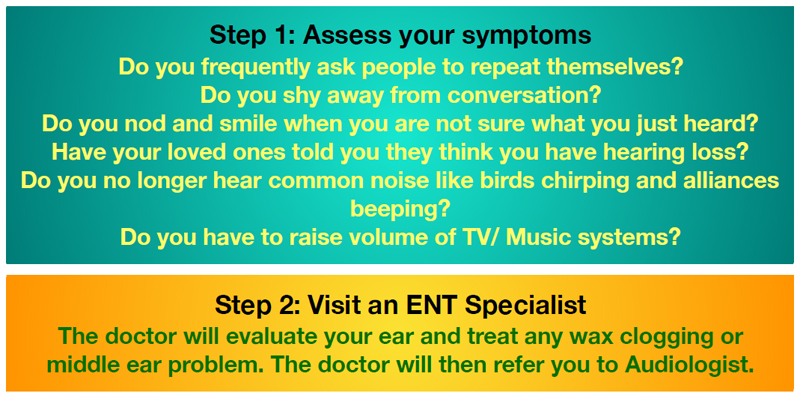Age Related hearing Loss: Presbycusis
What is age related hearing loss?
Age-related hearing loss (presbycusis) is the slow loss of hearing that occurs as we grow older.

Why does it happen?

• There are tiny hair cells in the inner ear that translate the sound waves into electrical signals for the brain to interpret as recognisable sound. As we grow older, these hair cells are damaged or die.
The hair cells DO NOT regrow, so most hearing loss caused by hair cell damage is permanent.
• Other less common causes include reduction of blood supply in the inner ear or thickening of the tissues within the inner ear.
• Sometimes, it could be because of the combination of the above causes.
What are the risk factors?

What are the symptoms?

Sometimes person may not realise that he is having hearing loss. Following may indicate age related hearing loss.
• Loss of clarity in hearing. One may hear but not understand the
words.
• Having to raise the volume on the TV
• Difficult to understand conversation in noisy areas
• Frequently asking people to repeat themselves
• Frustration at not being able to hear
• Certain sounds seeming overly loud
• Problems telling apart certain sounds, such as “s” or “th”
• More difficulty hearing higher pitched sounds, such as the telephone ring, appliance beep or birds chirping.
• Ringing or hissing in the ears
What are risks of untreated hearing loss?

Should we accept hearing loss as “part of getting older?”

Can we prevent or reverse age related hearing loss?

• However, you can protect your ears from sounds that are too loud and last too long thereby, limit the amount of hearing you might lose as you get older.
• Follow doctor’s guidelines for management of diabetes, heart disease or other circulatory problems. The hair cells in the inner ear depend on good blood flow to keep them healthy.
How is age related hearing loss treated?

There is no cure for age-related hearing loss. Treatment is focused on improving your everyday function.
Hearing aids:

• Hearing aids are the mainstay of treatment of age related hearing loss.
• They are electronic instruments you wear in or behind your ear.
• They make sounds louder.
• They are really effective in restoring the ability to communicate in mild to moderate hearing loss.
• Modern day hearing aids are completely digital, highly precise and can be customised according to the patients needs.
Other options include:
• Assistive listening device: Technology is available to amplify sound from your television, telephone and other personal electronic devices. ALDs can be used with or without hearing aids.
• Auditory rehabilitation: Sign language, lip reading and using visual cues to aid communication
• A cochlear implant may be recommended for people with severe hearing loss. Surgery is done to place the implant.
Step by step guidelines for a patient with age related hearing loss





